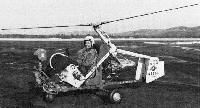
Фотографии
-
Aviation Historian 14 / N.Stroud - The Hot Seat
Регистрационный номер: N6256 [3] Летающее кресло Kaman KSA-100 SAVER. Непосредственно к креслу относятся элементы, окрашенные в белый цвет. Элементы, окрашенные в синий были необходимы для тестовых испытаний
Kaman chief test pilot F. Andrew Foster prepares for tests of the SAVER flight rig. The white portions of the machine, plus the rotor blades and engine, are the seat in its deployed mode. The controls for the test vehicle differed from those of the final proposed version, which was to be fitted with a small side-mounted control stick. -
Air Enthusiast 1972-04 / Airscene
Регистрационный номер: N6256 [3] The Kaman SAVER has recently been flight tested in the configuration shown. Claimed to be the world's first jet-powered autogyro, SAVER is an aerial escape and rescue capability (AERCAB) vehicle funded by the US Navy and is intended to provide a fighter's standard ejection seat with the ability to fly a considerable distance if an ejection is made over enemy territory.
-
Aviation Historian 14 / N.Stroud - The Hot Seat
Регистрационный номер: N6256 [3] After concluding that the concept was technically feasible as a result of windtunnel testing, the SAVER seat was attached to a steel frame for further testing under the supervision of the Naval Air Development Center (NADC). It is seen here with the final telescopic rotor, the hub of which, with a common flapping coning Delta 3 hinge offset by 3in.
-
Aviation Historian 14 / N.Stroud - The Hot Seat
The deployed SAVER seat during trials in the Ames 40ft x 80ft windtunnel.
-
Jane's All the World Aircraft 1972 / 01 - Aircraft
Kaman SAVER with dummy in crew seat during wind tunnel tests
-
Aviation Historian 14 / N.Stroud - The Hot Seat
The Kaman SAVER seat in its stowed position at the windtunnel at NASA's Ames Research Center. The rotor blades are coned upwards from the hub mounted on an A-frame, which hinges rearward to store the blades behind the seat.
-
Aviation Historian 14 / N.Stroud - The Hot Seat
The hub of final telescopic rotor, with a common flapping coning Delta 3 hinge offset by 3in.
-
Aviation Historian 14 / N.Stroud - The Hot Seat
The Kaman SAVER turbofan-powered autogyro was one of three projects developed for the American military’s AERCAB programme, and was the subject of a typically dynamic illustration by Fred L. Wolff to accompany an article on the concept in the September 1969 issue of Popular Mechanics.
-
Авиация и Космонавтика 2024-05 / О.Рязанцев - Последняя надежда пилота (4)
Последовательность развёртывания кресла Kaman KSA-100 SAVER








